Don’t you just HATE it when your chainsaw chain keeps coming off?
We ALL do!
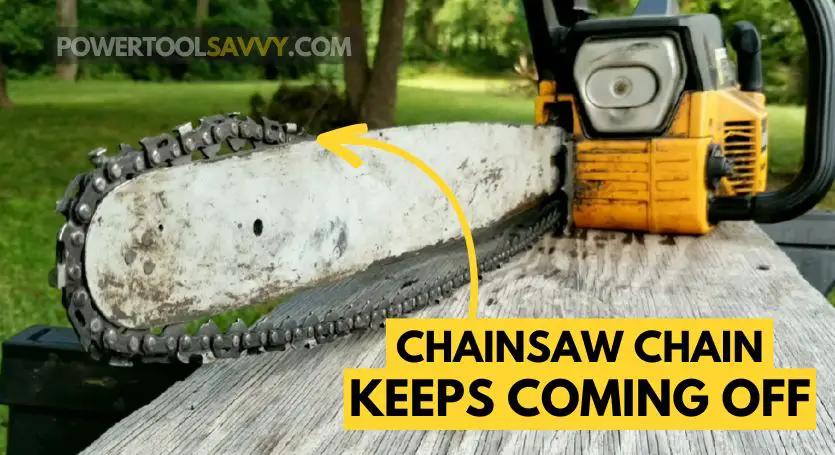
But have you ever wondered why your chainsaw chain keeps coming off?
If your chainsaw chain keeps coming off the bar, it might be due to improper chain tension. However, this issue can also occur if the drive sprocket is worn, the guide bar is damaged, the drive links are worn, or if you’re using the wrong size chain.
Okay…
But how can you fix these issues?
Well, that’s what this article is all about!
Throughout this article, I’m going to explain these causes in more detail & show you how you can FIX them.
So, let’s dive right in!
Table of Contents
ToggleYour Chain Might Be Too Loose
When a chainsaw chain keeps coming off the bar, nine times out of ten, it’s because the chain tension isn’t right.
(Here are 7 things that can cause your chainsaw chain to come loose!)
How to Tell if Your Chain is Loose?
Well, there’s a quick & easy technique to check that!
It’s called the “snap test“.
- Grab the chain with your left hand & pull it away from the bar.
- If the drive links nearly come out of the groove & snap back into place, your chain is correctly tensioned. But, if the chain hangs down below the bar, that’s a clear sign it’s too loose.
(Here’s an example: 👇)
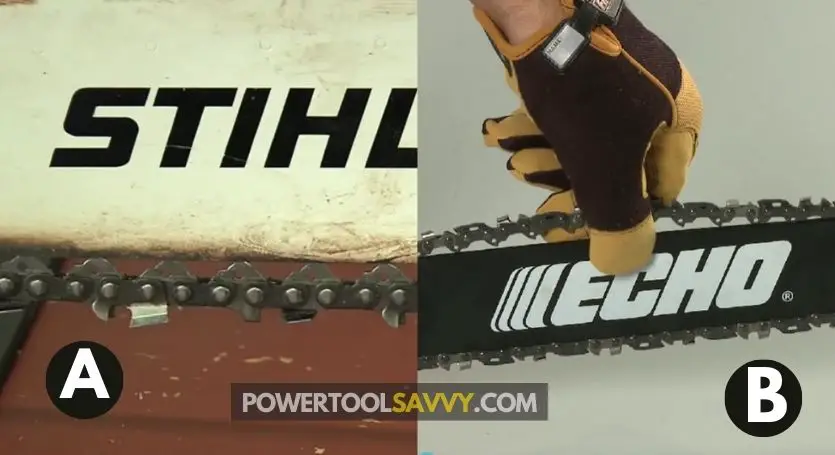
So, if you find out that your chain is loose, you should tighten it ASAP!
But hear me out.
It’s not about cranking it up to eleven; it’s all about finding that sweet spot!
Too loose, and it’s coming off like a sock on a hot day. Too tight, and you’re straining your motor and wearing out the chain.
Read this article where I’ve explained the full process of tightening a chainsaw chain the right way!
BONUS Tips
- Make sure your chain is cool when you tighten it. (This is because chainsaw chains stretch when they’re heated)
- Loosen the bar nuts before adjusting the tensioning screw.
- Hold the bar nose up when you tighten the chain.
Your are Probably Using a Worn-Out Bar
Chainsaw guide bars are durable enough to last the lifespan of 4 chains.
But, yet:
If you use your chainsaw roughly, don’t maintain it properly, or do a lot of heavy-duty work, you might wear out the guide bar much quicker than expected.
And a worn-out guide bar won’t be able to hold your chain securely for long, which can lead to the chain popping off during operation.
But how do you know if your guide bar is damaged or not?
How to Identify a Worn-Out Bar?
#1. If your chain doesn’t fit snugly in the bar groove & keeps moving from side to side, it’s a sure sign that the groove has become excessively wide, and you’ll need to get a new bar.
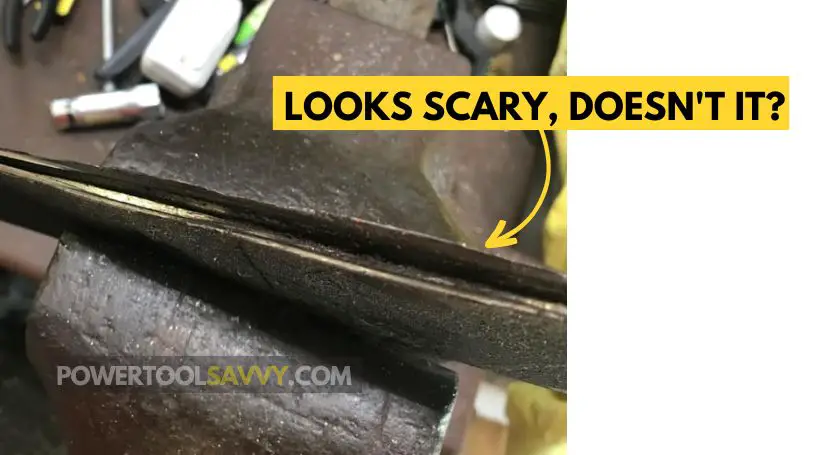
#2. Check the groove depth of your bar. If it’s less than the minimum required for your chain (refer to the chart below), your bar has seen better days!
| Chain Pitch | Min. Groove Depth Required |
|---|---|
| ¼” P | 4 mm |
| ¼” | 4 mm |
| ⅜”P | 5 mm |
| .325” | 6 mm |
| ⅜” | 6 mm |
| .404” | 7 mm |
#3. Check the nose sprocket of your bar. If it’s bent or missing tooth, you may need to replace the bar.
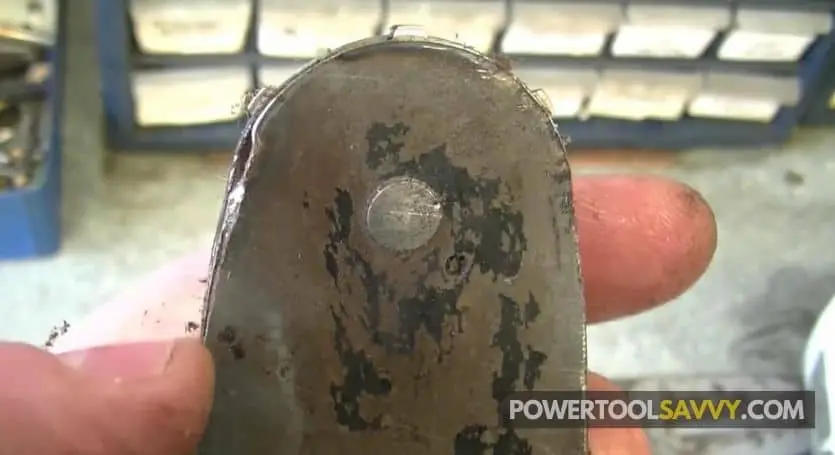
#4. Check the edges of your bar for cracks, bursts, and missing pieces.
#5. Check if the bar is bent, twisted, or warped.
The Solution
The solution is pretty simple!
If your guide bar is damaged, it’s BEST to replace it.
Continuing to use a damaged guide bar can be very dangerous. It may lead to kickbacks, loss of control, injuries, and, of course, chain derailments!
Read this article to learn more about replacing a chainsaw bar!
The Drive Links on Your Chain are Damaged
No problem with the guide bar?
Then it might be related to the drive links!
Let me explain:
Drive links are the lower part of your chain that fit into the groove on your guide bar & helps the chain move around.
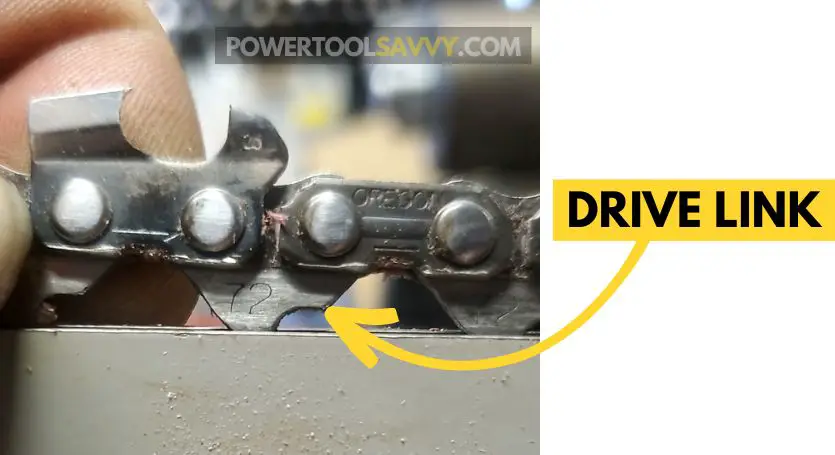
When the drive links are damaged or bent, they won’t fit securely in the groove on your bar. If this is the situation for you, your chain will frequently come off the bar!
Here’s an example of that:
But what causes damage to the drive links?
Well, it can be caused by hitting rocks (or other hard objects), getting pinched in a log, or even a poor installation of the chain.
But most often, drive links get severely damaged when the chain pops off the bar.
Here are 3 signs that the drive links on your chain are damaged:
- The links don’t fit into the bar groove.
- The chain doesn’t move smoothly when you pull it.
- You can see burrs & dents on the drive links.
What's the Solution?
Try filing the burrs off to get the drive links back to their original state.
If that doesn’t work, I would recommend getting a new chain! Check out this article where I’ve explained when & how should replace a chain in detail.
Your Sprockets Might be Worn Out
There are mainly 2 types of sprockets in a chainsaw –
- Drive sprocket: This sprocket is located on the clutch drum, and it’s responsible for pulling the chain around the bar.
- Bar nose sprocket: As the name suggests, the bar nose sprocket is positioned at the nose (tip) of the bar, and it guides the chain as it travels along the tip without losing momentum.
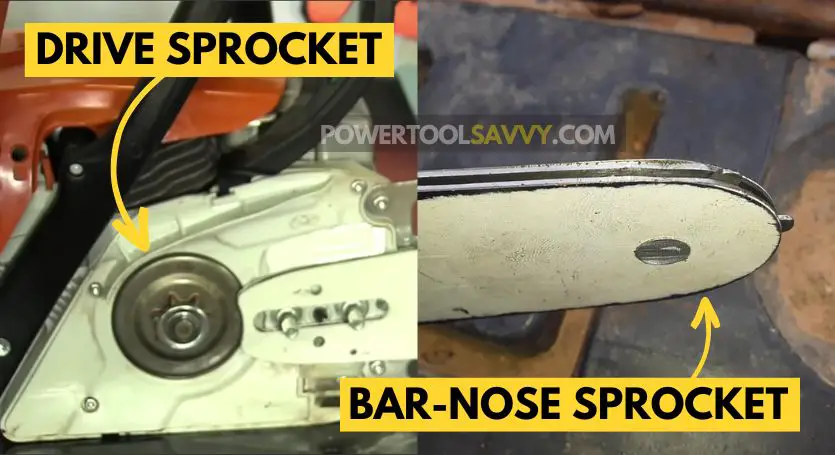
If either of these two sprockets gets worn out, it can make it difficult for your chain to stay on track, leading to more frequent chain derailments.
Drive Sprocket
In drive sprockets, there are 2 types. Here’s how they look when they get worn out:
- Spur sprocket (A): You’ll notice deep grooves on the teeth.
- Rim sprocket (B): You’ll notice that the gap between the channels has widened & exceeded the limit.
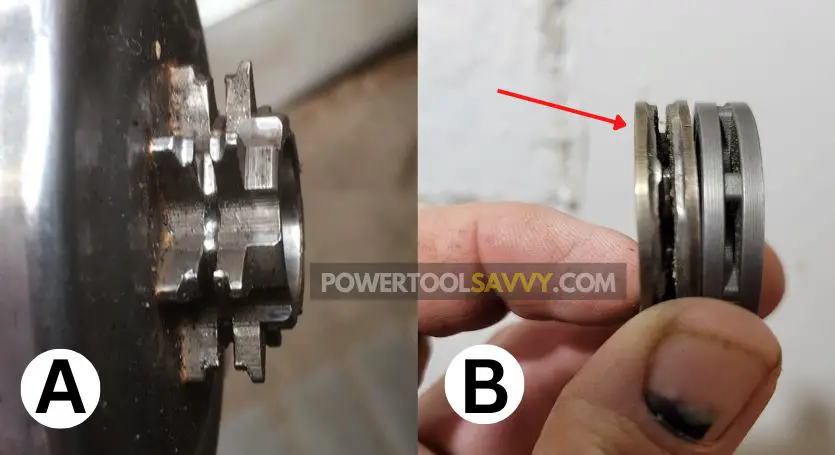
If your drive sprocket (rim/spur) looks the same, you need to replace it ASAP! Here’s a detailed guide on replacing drive sprocket.
Bar Nose Sprocket
Look for these tell-tale signs:
- Unusual shape of the teeth – If they look chipped or out of shape, it’s time for a replacement.
- Missing teeth – If the sprocket is missing one or more teeth, it needs to be changed.
- Loose sprocket – If it feels excessively loose, don’t wait for the chain to come off again. Put on a new sprocket asap.
- The sprocket is jammed – Check if the sprocket is jammed!
You're Probably Using the Wrong Size Chain
Here’s the truth:
Chainsaw chains are not universal. You can’t just grab a RANDOM chain and expect it to work on your saw!
A few days back, one of my friends was experiencing the same problem. His chain was slipping off the bar.
Later I found out that he was using the wrong size chain. (A big SLAP on his forehead!).
How to Tell if You're Using the Wrong Size Chain?
Well, it’s NOT rocket science!
All you need to do is to match these 3 specs of your chain to your bar:
- Chain pitch (Distance between any three consecutive rivets / 2)
- Number of drive link
- Chain gauge (Thickness of the drive links)
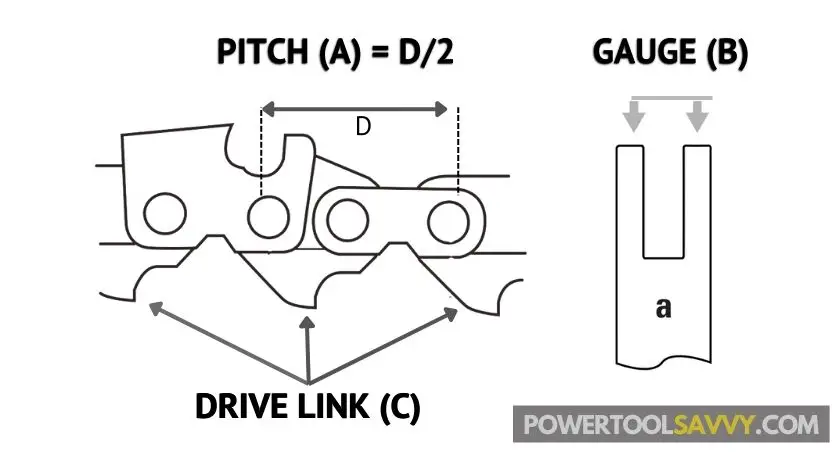
Usually, these specs are mentioned in your saw’s user manual. If you’re not using the stock chain, you can find this info on the packaging of the replacement chain.
Once you have the specs, compare them with the pitch, gauge, and drive link numbers written on your guide bar.
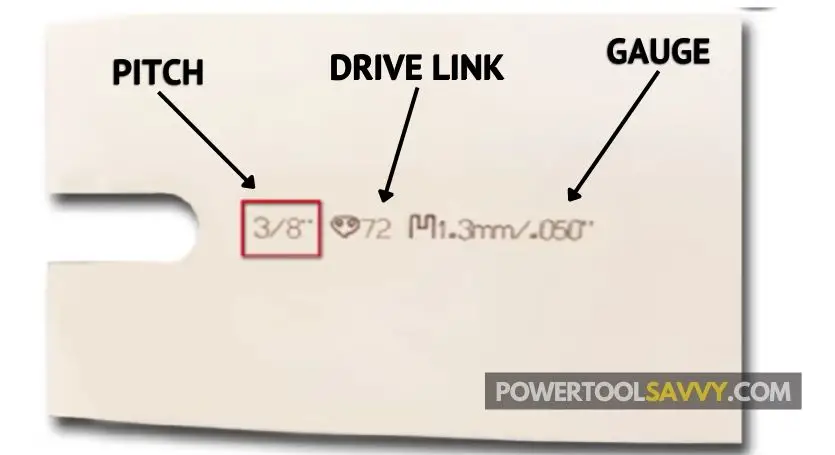
Doesn’t match?
You’re using the wrong chain!
Get a new chain. But this time, make sure it matches your bar’s pitch, gauge, and link count.
Your Chainsaw's Side Cover is Loose
Here’s the truth:
The side cover of your chainsaw isn’t just to protect the sprocket and the clutch, it also holds the bar and the chain in place.
If the cover isn’t firmly attached, it can cause the chain to get loose & come off the bar during operation.
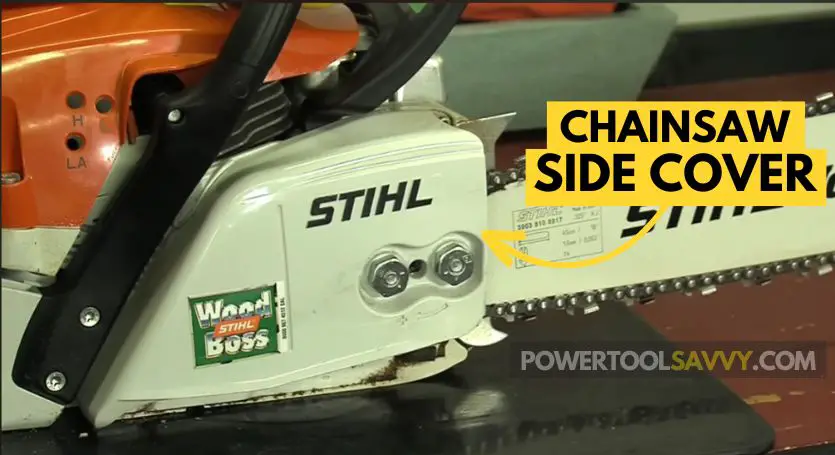
How Do You Fix This?
Very EASY!
- Gently raise the tip of your bar.
- Use a wrench to tighten the two nuts securing the side cover in place.
That’s all.
Are You Cutting Small Branches?
When you cut small branches or twigs with your chainsaw, the chain becomes wedged in the wood and pops off the bar. (This is due to the force of the chain being too great for a small branch to hold)
So, if your chain ONLY comes off when you’re cutting small branches, try to avoid this type of work. Rather use a hedge trimmer or brush cutter.
But, if you really need to cut the small branches, make sure you tighten the chain correctly & wear protective gear (gloves, safety glasses, etc.)
How to Put a Chain Back on the Chainsaw?
Follow the steps below to put your chain back on your chainsaw:
- Wear protective gloves.
- Turn the engine OFF & let the chain to cool down.
- Loosen the bar nuts & take off the clutch cover.
- Remove the chain. (Check if the drive links are broken, distorted, or worn out. Take out any debris that may be blocking the chain!)
- Put the chain back on the bar (making sure the cutters are in the right direction).
- Place the guide bar in position & re-attach the chain to the sprocket.
- Put the cover back on & tighten the bar nuts.
- Tighten the chain tensioner screw (while holding the bar nose UP!)
(If you’re still CONFUSED, check this video tutorial out!)

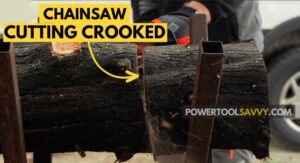
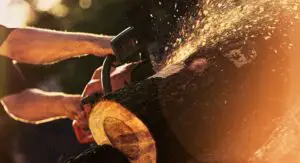
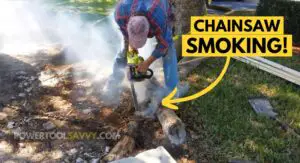
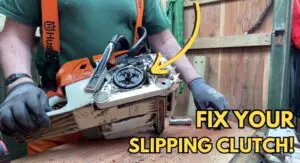
Pingback: How Long Does a Chainsaw Bar Last & When to Replace It
Pingback: When to Replace the Chainsaw Chain Sprocket? (Don't MISS!)
Pingback: Chainsaw Not Cutting? Here's How to Get It BACK in Top Form!
Pingback: How to Tighten a Chainsaw Chain - The Ultimate Guide
Pingback: How Tight Should a Chainsaw Chain Be? The Ultimate Guide!
Pingback: Chainsaw Chain Keeps Coming Loose? Here's How You FIX It!
Pingback: Chainsaw Cutting Crooked? Here's How to Get Straight Cuts!